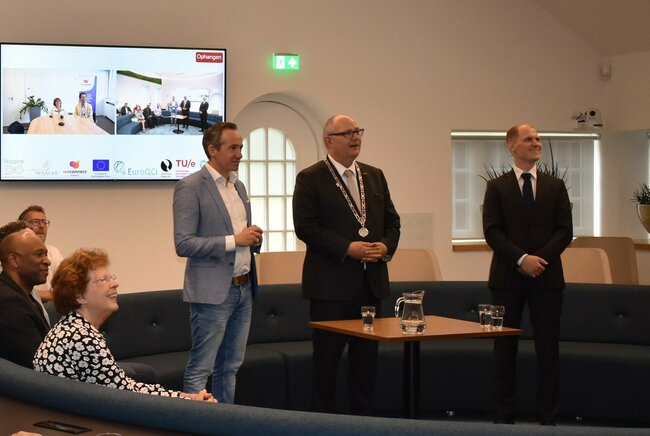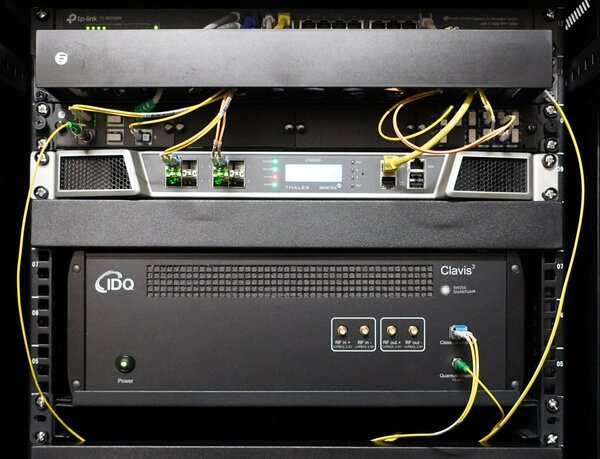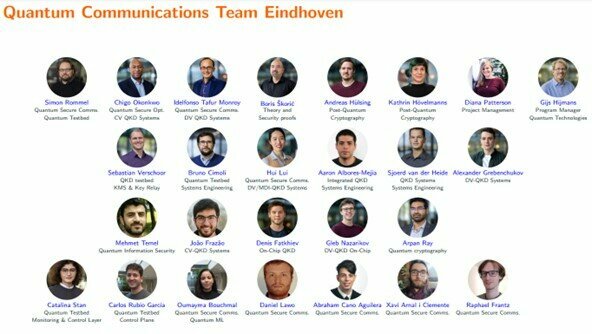Successful demonstration of first quantum secured local governmental connection in the Netherlands

On the 29th of June, TU/e together with WeConnect and Het Huis van Waalre successfully demonstrated the first quantum secured local governmental connection in the Netherlands. This marks a key milestone towards futureproof, fast, and secure telecommunications and shows market readiness of quantum communication technologies.

The demonstration took place between the Dutch municipality of Waalre and the local network operator WeConnect’s Waalre office. After a short introduction in the Raadzaal of Het Huis van Waalre, a team of scientists and engineers from Technical University of Eindhoven (TU/e) and the local telecom operator WeConnect established a secure communication channel to showcase a quantum secured videocall between mayor Marcel Oosterveer and alderman Peet van de Loo. During the call, a short presentation was given by dr. Sebastian Verschoor (TU/e) explaining the principles of quantum technology and the importance of quantum secured communications.
“Quantum computing poses a threat to existing security, but with the demonstration in the city of Waalre we show how quantum communications can provide a solution to overcome this threat, now and in the future.” says Verschoor, researcher and member of the Quantum Communications Team at TU/e.
The link was made possible through the cooperation of TU/e with WeConnect Waalre and Het Huis van Waalre, showcasing successful innovative collaboration in the Brainport region in addition to demonstrating the latest quantum secure communications technology. WeConnect as a local network operator deployed the optical fibre connection for this connection. The equipment for quantum key distribution (QKD) – the quantum technology employed to secure this link – and for establishing the network was installed by the team from TU/eat both ends of the link.
"WeConnect is the owner of its glass fibre network, and we are very happy to be able to bring to together TU/e and the municipality of Waalre to realise this secure connection. In Waalre we can be playground for the latest technologies and innovations, fitting with the innovation driven character of WeConnect. It is important to realise a secure connection with quantum technologies and to lay the foundations for secure communications for the coming 100years." says Marcel Menting, director or WeConnect Waalre.
This connection between the municipality of Waalre and WeConnect Waalre is part of the quantum technology agnostic Eindhoven quantum (secure) communications testbed currently under development to demonstrate quantum communications use-cases and drive the adoption of quantum (secure) communications. These efforts are funded by the Quantum Delta NL (QDNL) growth funds on Quantum Communications and by the QCINed project through the European Quantum Communications Infrastructure (EuroQCI) programme.
“Working with WeConnect and the Huis of Waalre has been an absolute pleasure in the preparation of this demo and is one of the first steps in building the testbed for quantum secure communications. We’re grateful to be able to collaborate with early adaptors with such innovative thinking such as WeConnect and the municipality of Waalre and to be able to bring our research from the lab to the eye of the public.” says dr.ir. Simon Rommel, assistant professor at the TU/e and leading the rollout of the testbed.
What is secure quantum communication?
Quantum computers are capable of breaking current encryption. This has been known for many years, but now that quantum computers are rapidly maturing a societal danger is created. Criminals and geopolitical enemies may gain access to critical information. There are many programs ongoing worldwide to counter this threat, with developments in the EU, USA, Japan and China being particularly well funded. At TU/e a large program is run to generate new quantum communication technology, test and validate it, and provide industry support for its further uptake and deployment.
Quantum Key Distribution (QKD) is the method we use to exchange cryptographic keys using quantum techniques. These keys in combination with next generation post-quantum cryptographic (PQC) algorithms provide protection to the widest class of attackers and therefore confidentiality and data security are guaranteed. Quantum key distribution, including the demonstration in Waalre, is one of the first steps towards a connected quantum internet, which will unlock the full potential of quantum communications technology, which promises secure and fast communication in the future.
Long-term security: Unlike traditional security methods, which are likely to be broken by quantum computers, the quantum key distribution at the heart of the quantum secure connection offers long-term security. Even with future advanced technologies like quantum computers, it will be impossible to compromise the distribution of the keys which are used to securely encrypt the data. Therefore, several sectors where quantum key distribution is attracting attention include banking, automotive, 5G systems, critical infrastructures, defence and security infrastructure.

Building a testbed for quantum (secure) communications
The realization of the first quantum secure local governmental connection is a milestone in the building of the Eindhoven technology agnostic testbed for quantum secure communication. In a major effort, TU/e is building a testbed to prove and further develop QKD and quantum communications technology. The testbed offers access to an extensive infrastructure which allows for real-world testing conditions and for developing new use cases for quantum technologies. The fibre network stretches from Eindhoven to Waalre, with a connection to Helmond coming soon.
“Demonstrating QKD and quantum secure communications in realistic deployed settings together with classical networks is absolutely key to show its added benefit and help the technology get adopted.” says Rommel.
Companies and researchers are invited to work within the testbed to develop components, systems, software and products for application in quantum communications. The testbed will also provide validation and certification for future commercial products. The work on the testbed combines the expertise from different groups in the Mathematics and Computer Science and Electrical Engineering departments, covering areas such as maths, information theory and cryptography, digital signal processing, telecommunications systems and networks, fibre optics and photonics, as well as software engineering and programming.

About Eindhoven University of Technology (TU/e)
Eindhoven University of Technology is a world leading education and research institution focused on advancing knowledge in science & technology for the benefit of humanity and educating the thought leaders of the future. The Eindhoven quantum key distribution efforts are led by the Quantum and Terahertz Systems and High-Capacity Optical Transmission teams in the Electro-Optical Communications group of the Department of Electrical Engineering. Besides the testbed, they develop different types of QKD equipment and pioneer integrated photonics for quantum secure optical communications.
About WeConnect Waalre
WeConnect believes it is important to connect Waalre not only digitally, but also socially. They do this by using the fiber optic networks for new innovative services that contribute to smart solutions, including in the field of safety and health. Various parties may use the open network for this purpose. All revenues are also reinvested to improve the network and roll out new valuable services. Check www.weconnectwaalre.nl for more information.
About the Quantum Network programme of the National Growthfund Quantum Delta NL and QCINed projects
The Quantum Network programme of QDNL and QCINed projects aim to deploy a national quantum network across the Netherlands and connect on international level. The projects aim to accelerate the technical developments of QKD and Quantum Internet technology in the Netherlands, integrate quantum networks with classical communication networks and to develop quantum communications, pilot devices and systems. A further objective of these projects is to contribute to the training of technical and research staff in aspects related to quantum communications and to inform and guide relevant public authorities.
The research leading to this demonstration event is part of the QDNL and QCINed projects which have received funding from the Dutch Ministry of Economic Affairs and Climate Policy (EZK), as part of the Quantum Delta NL programme and from the European Union’s Digital Europe research and innovation programme under grant agreement no. 101091656.
Reference for technical details/research: dr.ir. Simon Rommel s.rommel@tue.nl
